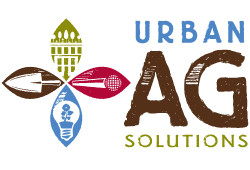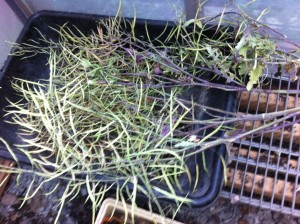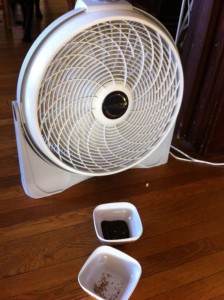I love collecting seeds. I love the fact that in this modern, hyper-complexified world where even the simple act of drinking a cup of water seems attended to by a thousand technocrats, I can plant a crop, harvest and be nourished by it, and then (depending on the crop, of course) save its seeds to ensure my and my loved ones’ ongoing nourishment. Now I’m no Luddite or raving Libertarian, so I won’t be going on and on about how we need to go back to the land or how we need to get government off our backs, and yet seed saving makes me de facto something of both: my seed-saving methods are beautifully, almost Neanderthalically non technical, and by saving my own, I’ll avoid “the man” who wants to either tax or genetically modify and somehow “improve” almost every living thing out there.
OK, I am now stepping off my soapbox and am going to just hand over the facts. What I’m demonstrating here is seed saving for Red Russian kale, which I eat almost year-round. By saving my own seed, I can afford to treat kale like a weed, meaning that because I can collect large quantities of the seed for a pittance of time and energy, I can profligately fling the seed everywhere and let it grow up in the interstices and gaps in the garden. In fact, at the school garden, I have completely stopped planting kale, and yet each year we have an abundant crop. It is growing in so many little corners, and it just matures, sheds its seed wherever it is and ensures its perpetuation into the next season. In that case I don’t save the seed or plant it; all I do is weed it from where I don’t want it, then I let it do its thing from there. Couldn’t be easier!
But our focus here is on gathering and saving seed, which does require at least a minimal amount of work and focus. For materials you should gather the following: one kale plant ripe and ready with seed (see pic below); a dry area and a tarp or large container; a large, clean drum or garbage can; a couple bowls and possibly a fan (or wind…more on that later); and an envelope and a marker.
Here goes.
This is a Red Russian kale plant after maturing. It’s demur, ground-hugging, finger-leafed personality has totally changed, and it’s become a crazed, Medusa-haired creature with yellow, ratty leaves and a peck of swollen, pinky-sized pods. When the pods are swollen but not split and turning from green to yellow, that is a great time to pull it. Just yank it up roots and all. Here I have placed the whole plant in a cement mixing tray on the ground level of my greenhouse, where it can continue to dry out, and if some of the pods shatter in the process, the seed will be contained by the tray. You could also place it on a tarp. Just make sure it’s out of direct sun and that it won’t get wet from irrigation or rain.
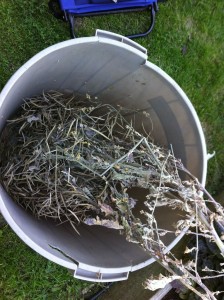
Now comes the fun. When the plant seems sufficiently dry and the pods want to crack open under slight pressure, revealing the precious, little brown seeds within, then you gingerly take the plant, place it into a clean, dry container (like this old, partially cracked garbage can I have saved expressly for the purpose…to my wife’s delight, I might add) and shake the thing for all you’re worth. As you are thrashing that dead plant against the walls of the container, you might as well go and cancel your next therapy session because you are basically self-managing your anger, channeling it into healthy and positive work. I am proud of you.
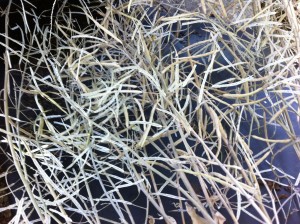
At this stage you will remove the stalks and empty pods, which will look like this. At the bottom of the bucket/can/container will be a small pile of seeds and a lot of loose, duffy-looking stuff called chaff. It is now your job to separate the seeds from the chaff, which is akin to the Biblical house- cleaning at Judgement Day (as in “He will separate the wheat from the chaff” sort of thing). So take any moral lesson you might from the following process and plunge in. Transfer the seeds from the large container into a smaller, more reasonably-sized bowl and use one of three methods to complete the separation:
1) Blow gently into the bowl while swishing it around. The chaff will blow out all over the place, including all over your face, hair and neck. This may cause itching, but it is effective, especially because you control how hard you blow. As you swish the bowl and blow, lighter chaff constantly rises to the surface and gets removed, and pretty soon only (or mostly only) seeds remain.
2) Get two bowls and go outside. If the wind is gentle and steady, simply pour the seeds and chaff between the bowls. The seed, because it is heavier, should fall into the other bowl straightaway, and the lighter chaff should get blown away. If you judge wind direction properly, you should not get chaff in the face as in method 1. Also you may have to vary the distance of your pour to allow enough time for the wind to act on the chaff. If the wind is too strong, then even with the bowls a short ways apart, it may blow your seeds every which way, so use common sense and test it first before you commit to this method.
3) Use a fan to help you achieve the correct wind velocity. Although I show a fan indoors, I recommend using it on a porch or in the back yard for obvious avoidance of a mess inside the house
.
I used method 1 yesterday because I was in a hurry and there wasn’t a great wind, and even though I did have to pay the price of a lot of plant junk winding up in my hair, at the end of it all I was the proud owner of 1/3 of a cup of fresh, Red Russian kale seed. That’s got to be at least a couple thousand seeds, meaning that I could eat kale until I go green in the face and then still have plenty to give to fam and the neighbors. And that’s just from ONE plant!
Last step is to put the seed in an envelope and label the variety and date. All seed, as with all living things, eventually perishes, and eventually you will have to grow out the plant and save seed again. The length of seed viability varies from over a thousand years to a few weeks. Most veggie crops are good for at least a few years, provided they are kept cool and dry. You can use a book like Suzanne Ashworth’s excellent Seed to Seed to find out exactly how long a life expectancy your particular crop’s seeds will have. Also that reference will give you valuable tips about whether you may have to isolate the crop you intend to save seed from and how many of a particular plant you will need to insure good seed.
Basically, seed saving is easy, fun, and necessary. Seeds are sold in catalogs and racks only because there is a market for them. If the market dries up, you could be out your favorite crop, so get in the habit of saving some seeds, both to save yourself some cash and to help keep something valuable alive.
We’ll discuss other seed saving as the season goes on, but as soon as the kale is ready, I know seed season has truly begun.
